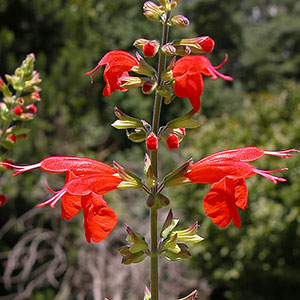Scarlet Salvia

Scarlet salvia attracts hummingbirds, butterflies, and other pollinators with its rich red, tubular flowers that appear from spring through fall. This native salvia is at its best during the hottest summer months when other flowering plants are wilting in the heat.
Sometimes called tropical sage, Salvia coccinea is a perennial that can be planted anywhere in the state. Scarlet salvia grows up to 3-4 feet, in many different conditions, and is fairly drought tolerant.
Salvias are herbaceous plants, usually with square stems and flowers borne in spikes. Despite its name, scarlet salvia flowers can also be pink or white. Mass it together, mix it with other perennials in a border, or feature it in a container garden.
Plant your scarlet salvia in full to partial sun, although flowering will be reduced in part shade. These plants thrive in well-drained soils and are considered relatively free of pest and disease problems.
When planting, place transplants 24-36 inches apart for optimum growth. To plant a potted salvia, water your plant before taking it out of the container. Dig a hole that is two times the width of the container. Backfill the hole and plant your salvia one inch above the soil level. Add water and more soil to your newly planted salvia as necessary. You can add mulch around the plant to help conserve water and keep weeds down.
To maintain a neat-looking landscape, lightly prune it during the flowering season. Cut it back at the end of the year when the foliage begins to die or after damage from a freeze.
Salvia often self-propagates, so you might find seedlings you can use in other parts of your landscape.
To learn more about scarlet salvia and other native pollinator plants, contact your county Extension office.
Also on Gardening Solutions
- Gardening for Butterflies
- Gardening for Fall Color
- Hummingbird Gardens
- Native Plants
- Salvias
- Summer Bedding Plants
